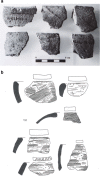On the Origins and Dissemination of Domesticated Sorghum and Pearl Millet across Africa and into India: a View from the Butana Group of the Far Eastern Sahel
- PMID: 30880862
- PMCID: PMC6394749
- DOI: 10.1007/s10437-018-9314-2
On the Origins and Dissemination of Domesticated Sorghum and Pearl Millet across Africa and into India: a View from the Butana Group of the Far Eastern Sahel
Abstract
Four decades have passed since Harlan and Stemler (1976) proposed the eastern Sahelian zone as the most likely center of Sorghum bicolor domestication. Recently, new data on seed impressions on Butana Group pottery, from the fourth millennium BC in the southern Atbai region of the far eastern Sahelian Belt in Africa, show evidence for cultivation activities of sorghum displaying some domestication traits. Pennisetum glaucum may have been undergoing domestication shortly thereafter in the western Sahel, as finds of fully domesticated pearl millet are present in southeastern Mali by the second half of the third millennium BC, and present in eastern Sudan by the early second millennium BC. The dispersal of the latter to India took less than 1000 years according to present data. Here, we review the middle Holocene Sudanese archaeological data for the first time, to situate the origins and spread of these two native summer rainfall cereals in what is proposed to be their eastern Sahelian Sudan gateway to the Red Sea and the Indian Ocean trade.
Quatre décennies se sont écoulées depuis que Harlan et Stemler ont proposé la zone sahélienne orientale comme le centre le plus probable de la domestication du sorgho bicolore. Récemment, de nouvelles données sur les impressions de semences sur les poteries du groupe Butana du IVe millénaire avant JC dans la région sud d’Atbai dans la ceinture sahélienne d’Afrique orientale montrent des preuves d’activités de culture du sorgho présentant certains traits de domestication. Pennisetum glaucum pourrait être en cours de domestication peu après dans l’ouest du Sahel, puisque le millet perlé entièrement domestiqué est. présent dans le sud-est du Mali vers la seconde moitié du troisième millénaire avant J.-C. et présent dans l’est du Soudan au début du deuxième millénaire avant notre ère. La dispersion de ce dernier en Inde a pris moins de mille ans selon les données actuelles. Nous examinons ici pour la première fois les données archéologiques soudanaises de l’Holocène moyen pour situer les origines et la propagation de ces deux céréales de pluie estivales indigènes dans ce qui est. proposé comme leur porte d’entrée soudanienne du Sahel oriental à la mer Rouge et à l’océan Indien.
Keywords: Archaeobotany; Butana Group; Nubia; Origins of agriculture; Pennisetum glaucum; Sorghum bicolor.
Conflict of interest statement
Compliance with Ethical StandardsThe authors declare that they have no conflict of interest.
Figures








Similar articles
-
Transition From Wild to Domesticated Pearl Millet (Pennisetum glaucum) Revealed in Ceramic Temper at Three Middle Holocene Sites in Northern Mali.Afr Archaeol Rev. 2021;38(2):211-230. doi: 10.1007/s10437-021-09428-8. Epub 2021 Mar 16. Afr Archaeol Rev. 2021. PMID: 34720323 Free PMC article.
-
Contrasting patterns in crop domestication and domestication rates: recent archaeobotanical insights from the Old World.Ann Bot. 2007 Nov;100(5):903-24. doi: 10.1093/aob/mcm048. Epub 2007 May 10. Ann Bot. 2007. PMID: 17495986 Free PMC article. Review.
-
Inference of domestication history and differentiation between early- and late-flowering varieties in pearl millet.Mol Ecol. 2015 Apr;24(7):1387-402. doi: 10.1111/mec.13119. Epub 2015 Mar 20. Mol Ecol. 2015. PMID: 25705965
-
Comparative analysis of QTLs affecting domestication traits between two domesticated x wild pearl millet ( Pennisetum glaucum L., Poaceae) crosses.Theor Appl Genet. 2002 May;104(6-7):965-975. doi: 10.1007/s00122-002-0889-1. Epub 2002 Apr 6. Theor Appl Genet. 2002. PMID: 12582601
-
A Population Genetic Perspective on Subsistence Systems in the Sahel/Savannah Belt of Africa and the Historical Role of Pastoralism.Genes (Basel). 2023 Mar 20;14(3):758. doi: 10.3390/genes14030758. Genes (Basel). 2023. PMID: 36981029 Free PMC article. Review.
Cited by
-
Leveraging the Potential of Sorghum as a Healthy Food and Resilient Crop in the South African Food System.Front Sustain Food Syst. 2022 May 20;6:786151. doi: 10.3389/fsufs.2022.786151. Front Sustain Food Syst. 2022. PMID: 39015344 Free PMC article.
-
Agricultural diversification in West Africa: an archaeobotanical study of the site of Sadia (Dogon Country, Mali).Archaeol Anthropol Sci. 2021;13(4):60. doi: 10.1007/s12520-021-01293-5. Epub 2021 Mar 8. Archaeol Anthropol Sci. 2021. PMID: 33758626 Free PMC article.
-
Natural variation in Glume Coverage 1 causes naked grains in sorghum.Nat Commun. 2022 Feb 25;13(1):1068. doi: 10.1038/s41467-022-28680-3. Nat Commun. 2022. PMID: 35217660 Free PMC article.
-
The Road to Sorghum Domestication: Evidence From Nucleotide Diversity and Gene Expression Patterns.Front Plant Sci. 2021 Aug 30;12:666075. doi: 10.3389/fpls.2021.666075. eCollection 2021. Front Plant Sci. 2021. PMID: 34527004 Free PMC article.
-
Cyanogenesis in the Sorghum Genus: From Genotype to Phenotype.Genes (Basel). 2022 Jan 14;13(1):140. doi: 10.3390/genes13010140. Genes (Basel). 2022. PMID: 35052482 Free PMC article.
References
-
- Abdel-Magid, A. (1989). Plant domestication in the Middle Nile Basin—An archaeobotanical case study. International Series 523. Oxford: British Archaeological Reports.
-
- Abdel-Magid A. Exploitation of food-plants in the Early and Middle Holocene Blue Nile area, Sudan and neighbouring areas. Complutum. 2003;14:345–372.
-
- Allaby R. Integrating the processes in the evolutionary system of domestication. Journal of Experimental Botany. 2010;61:935–944. - PubMed
-
- Allaby R, Brown T, Fuller D. A simulation of the effect of inbreeding on crop domestication genetics with comments on the integration of archaeobotany and genetics: A reply to Honne and Heun. Vegetation History and Archaeobotany. 2010;9(2):151–158.
-
- Amblard S, Pernès J. The identification of cultivated pearl millet (Pennisetum) amongst plant impressions on pottery from Oued Chebbi (Dhar Oualata, Mauritania) African Archaeological Review. 1989;7:117–126.
Publication types
LinkOut - more resources
Full Text Sources
